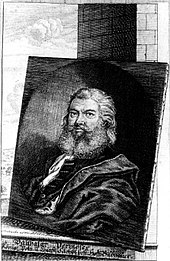Balthasar Permoser

Balthasar Permoser (* 13. August 1651 in chamber at Traunstein , † 20th February 1732 in Dresden ) was one of the most important sculptor of the Baroque .
life and work
Balthasar Permoser's birthplace Kammer, now part of the Upper Bavarian town of Traunstein , was part of the Salzburg parish of Otting .
Permoser was trained as a sculptor in Salzburg and was a student of Wolf Weißenkirchner and Giovanni Battista Foggini . Giovanni Lorenzo Bernini and Pierre Puget are regarded as role models . Permoser is recorded in Vienna in 1670, followed by a longer stay in Italy from 1675 to 1689, which was to have a decisive influence on him. Permoser spent most of this time in Florence .
In 1689, the Salzburg resident was appointed court sculptor by Elector Johann Georg III. Appointed to Dresden and from 1694 created numerous works under his son August the Strong . His diverse activities in Dresden, especially for the Saxon court, were interrupted by repeated trips to Italy (1697/1698 and 1725), Salzburg, Vienna and Berlin .
Permoser is the most important and most influential mediator of the formal ideas of Italian baroque sculpture to Germany. The main works include, above all, the sculptural jewelry for the Dresden Zwinger (from 1711), which is now considered the main work of the Dresden Baroque . The overall concept for the design and numerous figures made of wood , stone and ivory come from Permoser . Particularly noteworthy is the apotheosis of Prince Eugene in Vienna.
Permoser did not exhaust himself in artificial mastery, but penetrated his characters spiritually, they seem animated; no matter whether he snatches the powerful body of a volcano or the gentle girl's face of a nymph from the stone, for example in the wall pavilion of the Zwinger, whether he creates overflowing abundance, as in the pulpit of the Catholic Court Church or the firmness of faith with the church fathers, the torment of Marsyas or that the mute sufferings of Christ, “there is always truthfulness in his work”.
Permoser was considered a master and teacher for a whole generation of Saxon sculptors; Dominikus Moling and Anton Carl Luplau are among the artists influenced by Permoser .
He was productive well into old age; the work on the kennel falls into his seventh decade of life. Balthasar Permoser found his final resting place in the Old Catholic Cemetery on Friedrichstrasse in Dresden. In his memory, the main street through his birthplace is now called Balthasar-Permoser-Straße.
Nymph bath in the Dresden Zwinger
Moor with emerald step in the Green Vault in Dresden
Pulpit in the Catholic Hofkirche Dresden
literature
- Sigfried Asche: Balthasar Permoser and the baroque sculpture of the Dresden Zwinger. Frankfurt a. M. 1966.
- Sigfried Asche: Balthasar Permoser - life and work. Berlin 1978.
- Wilhelm Boeck : Balthasar Permoser. The sculptor of the German baroque . August Hopfer Verlag, Burg near Magdeburg 1938.
- Johannes Glötzner: Permoser's Blessed Roses - News and curiosities about Balthasar Permoser. Munich 2005.
- Johannes Glötzner: Permoser's Beard Book - A bearded research on the Dresden sculptor. Munich 2006.
- Johannes Glötzner: Permoser's beard. Historical factual novel. Munich 2008.
- Erich Hubala: The art of the 17th century. Propylaea Art History, Volume 9. Berlin 1970.
- Albert Ilg: Permoser, Balthasar . In: Allgemeine Deutsche Biographie (ADB). Volume 25, Duncker & Humblot, Leipzig 1887, pp. 382-384.
- Joachim Menzhausen : Permoser, Balthasar. In: New German Biography (NDB). Volume 20, Duncker & Humblot, Berlin 2001, ISBN 3-428-00201-6 , pp. 190-192 ( digitized version ).
- Dietrich Nummert : Wanderer “per il mondo” - the sculptor Balthasar Permoser (1651–1732) . In: Berlin monthly magazine ( Luisenstädtischer Bildungsverein ) . Issue 7, 2001, ISSN 0944-5560 , p. 76-84 ( luise-berlin.de ).
Movies
- Between baroque and rococo - the court sculptor Balthasar Permoser. Documentary film by Bernhard Graf . BR 2001.
Web links
- Literature by and about Balthasar Permoser in the catalog of the German National Library
Individual evidence
- ↑ Erich Hubala: The art of the 17th century. Propylaea Art History, Volume 9. Berlin 1970, p. 333.
- ↑ Hagen Bächler and Monika Schlechte: Guide to the Baroque in Dresden , Dortmund 1991, p. 19
- ↑ See description in the collection database . Retrieved July 8, 2011.
| personal data | |
|---|---|
| SURNAME | Permoser, Balthasar |
| BRIEF DESCRIPTION | German sculptor |
| DATE OF BIRTH | August 13, 1651 |
| PLACE OF BIRTH | Chamber near Traunstein |
| DATE OF DEATH | February 20, 1732 |
| Place of death | Dresden |






